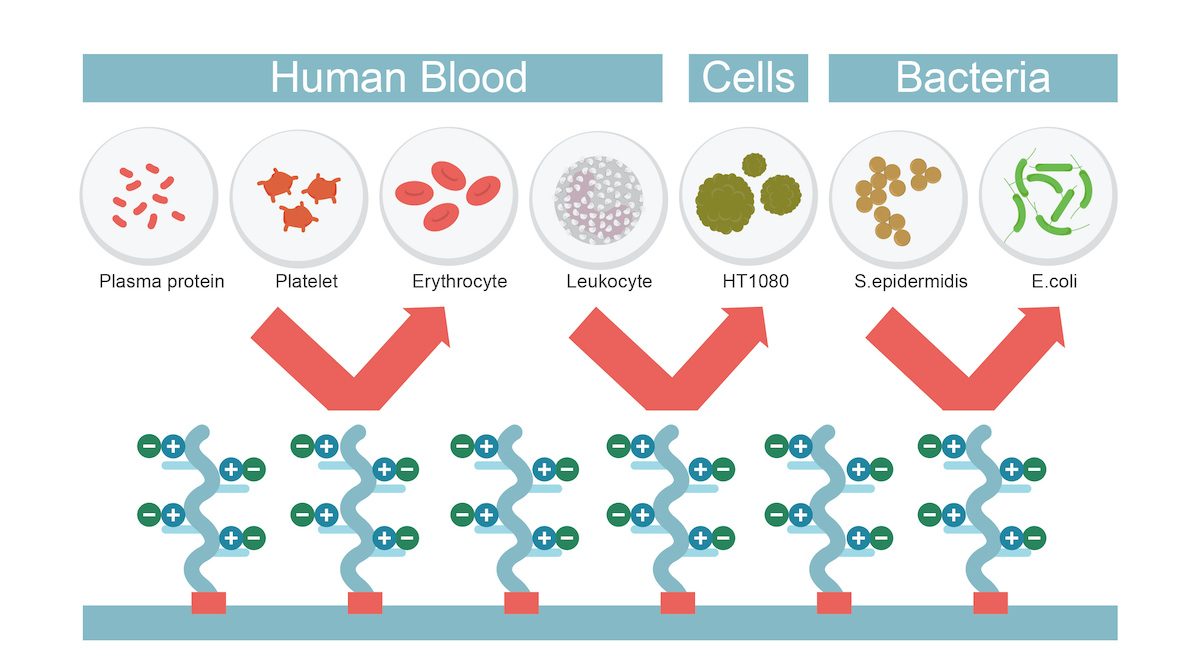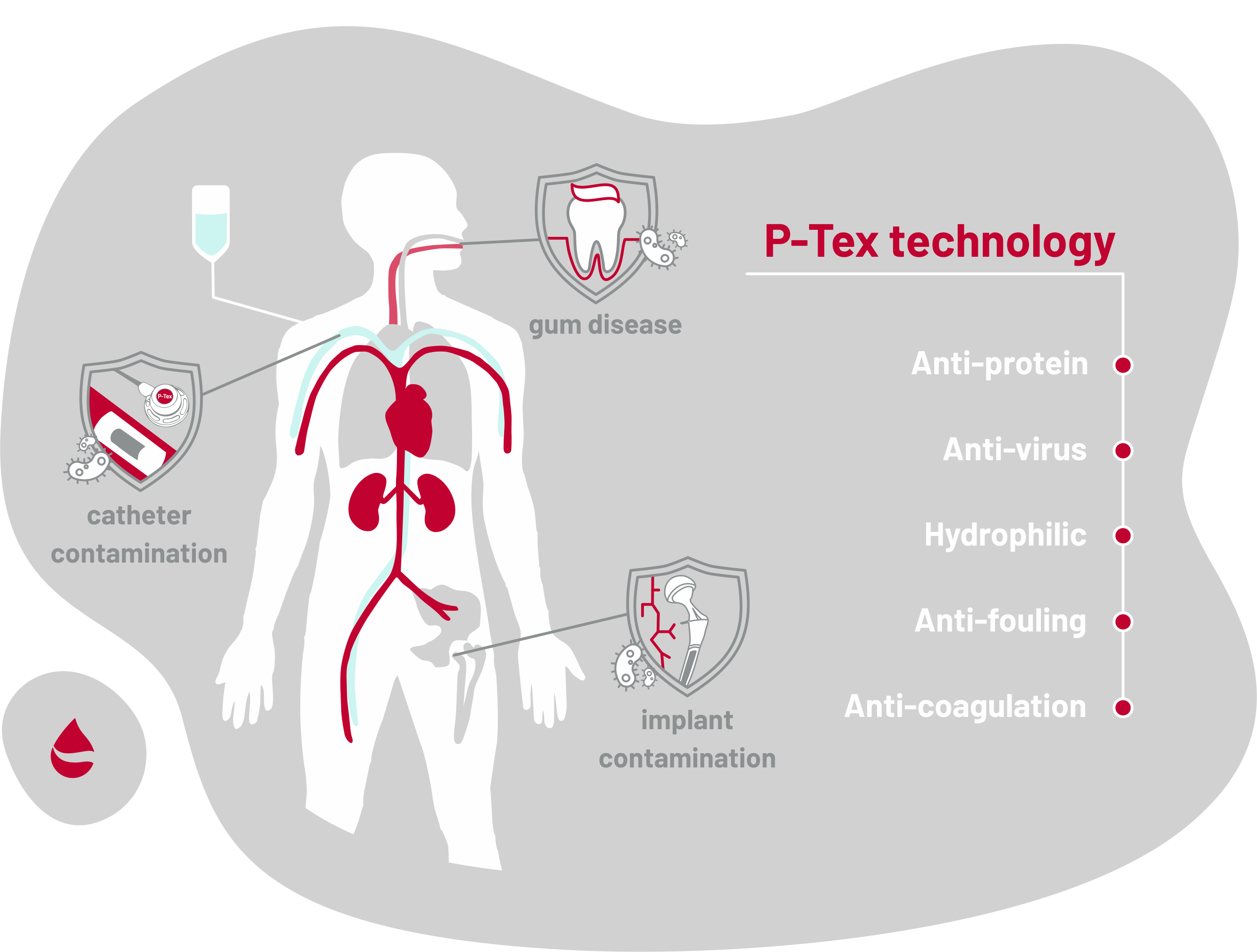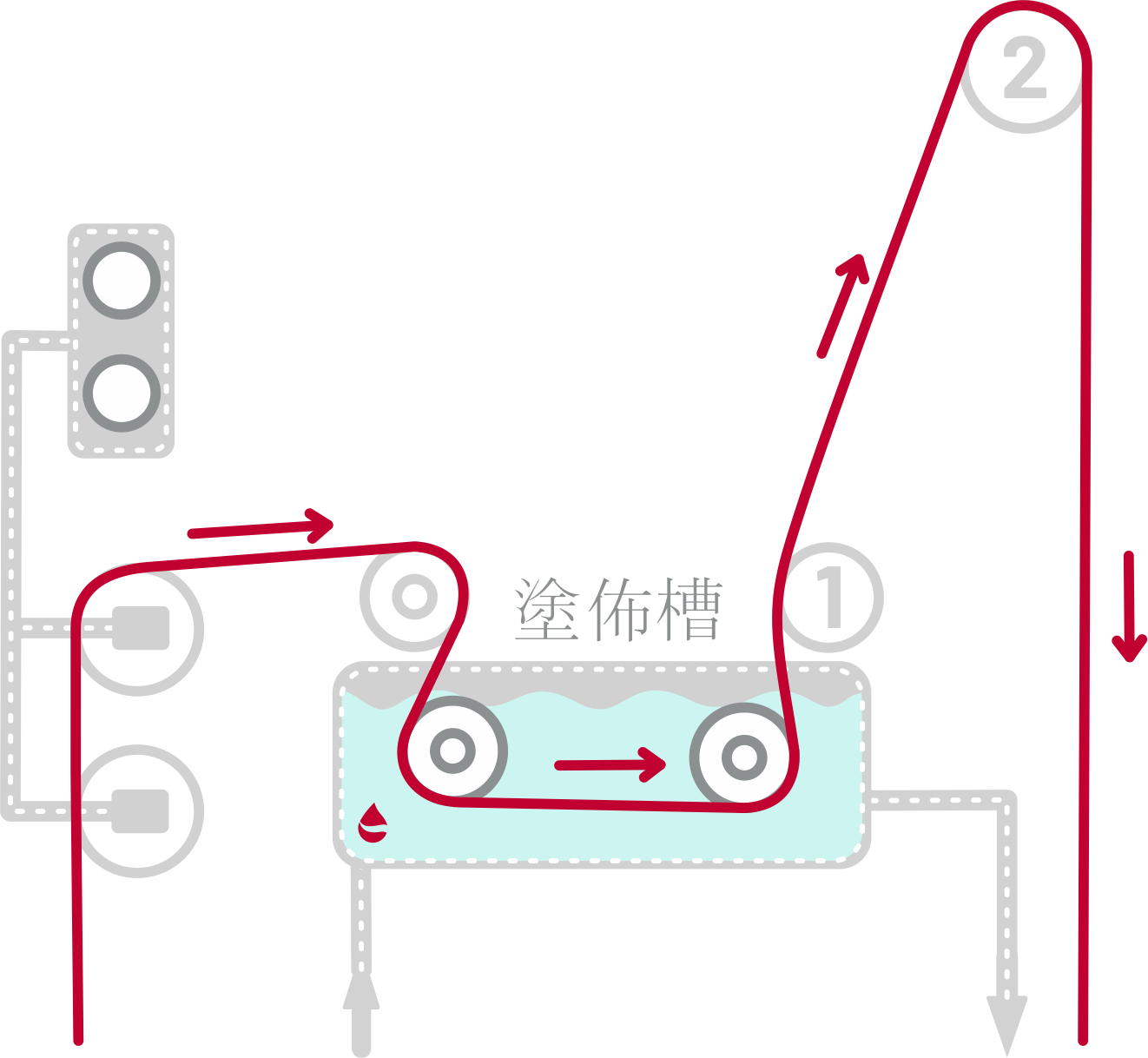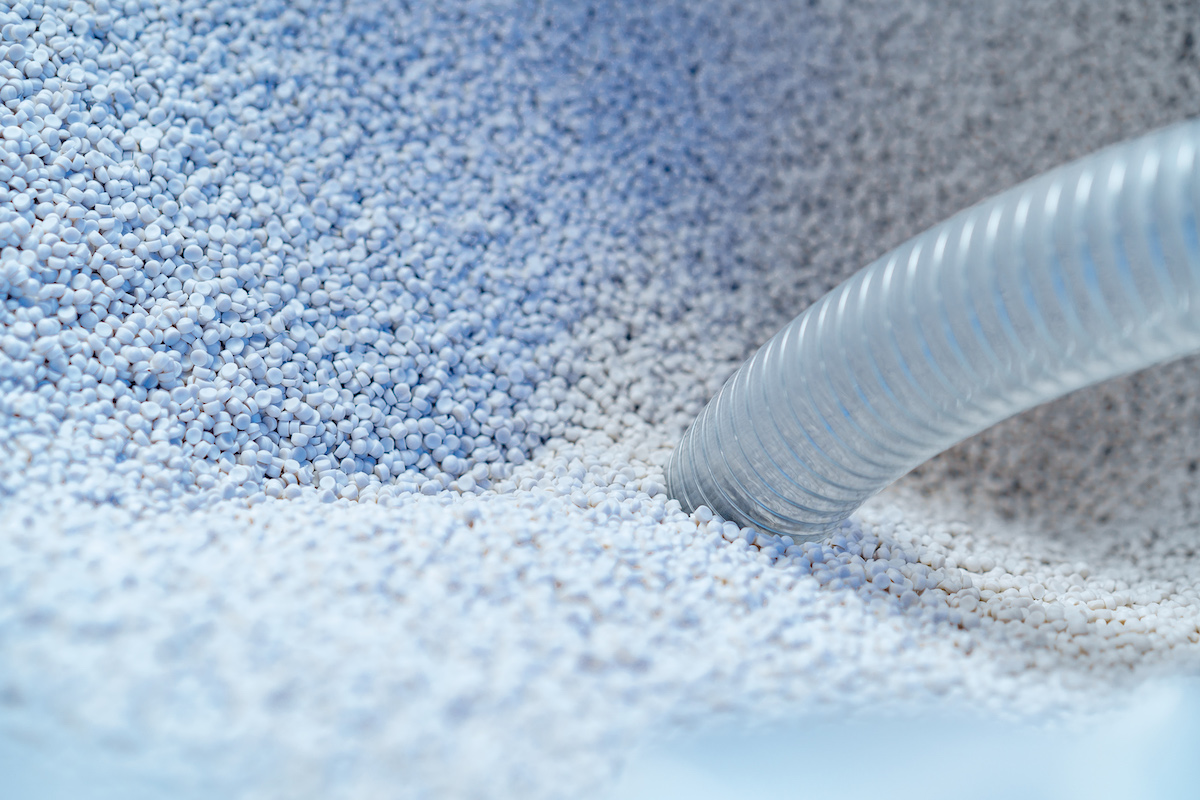P-Tex 可以穩定地塗覆或嵌入所需材料的表面或內部。 它為目標表面提供了抗生物污染的特性,同時具有高度生物相容性的特點。經P-Tex處理後的材料可以抵抗任何生物的附著,同時在同一環境中保持共存,並同時保有以下特性:抗蛋白質/抗病毒/抗凝血/抗組織粘連/抗菌/抗生物聚集等。
P-Tex是一種先進的抗沾黏技術,由仿生分子式 “雙離子聚合物”與兩親鏈段組成。 由於P-Tex具有上述特性,尤其適合應用於醫療器材領域,有效降低汙染風險,同時保有生物相容性。 例如右圖之應用: P-Tex 塗層可以通過浸泡或是塗佈等方式添加到任何所需的材料中。透過加工在主要材料表面形成自組裝的雙離子化學結構,賦予材料上述特徵。 通過在原料中加入P-Tex,賦予材料或製品本身前述特性,無需額外的表面塗層處理。 目前研發項目含括:工業塑料添加劑和醫療塑料添加劑。 賦予所需材料以下功能 白血球過濾系統/牙科植體 實驗室用注射型過濾器 傷口敷料 醫療消耗品 (試管/細胞培養袋) 運輸船用或 一般船隻防污塗料 己完成 目前階段 Mei-Chan Sin, Sheng-Han Chen & Yung Chang Fundamental development of nonfouling zwitterionic poly(sulfobetaine methacrylate) (polySBMA) coatings on a wide range of interfaces and membranes for use in the development of hemocompatible medical devices was discussed. The molecular designs of zwitterionic interfaces as well as the evolution of ‘intelligent’ interfaces and correlations between zwitterionic polymeric membrane surface modifications are scrutinized and delineated. Yung Chang, Shengfu Chen, Qiuming Yu, Zheng Zhang, Matthew Bernards, and Shaoyi Jiang Interpenetrating polymer networks (IPNs) were prepared by the modification of a segmented polyurethane (SPU) with a cross-linked sulfobetaine methacrylate (SBMA) polymer. The IPN films that were prepared can effectively resist nonspecific protein adsorption when the distribution of SBMA units within the SPU film is well controlled, and they retain high mechanical strengths inherent from the base SPU films. Furthermore, the zwitterionic and biomimetic nature of sulfobetaine and the ease of SBMA preparation make SBMA-based materials very attractive for a wide range of applications. It is challenging to control the diffusion of highly polar SBMA into the hydrophobic network of SPU. In this study, various parameters governing the formation of IPNs containing SBMA were studied. The chemical composition depth profile of the IPN films was determined by confocal Raman microscopy. The morphology and thickness of these IPN films were examined by atomic force microscopy and scanning electron microscopy. The amount of adsorbed proteins on the IPN films was determined by an enzyme-linked immunosorbent assay. Results show that the amount of adsorbed proteins on the IPN films depends on the incubation conditions, including solvent polarity, incubation time, SBMA monomer ratio, and incubation concentration. It appears that the IPN films prepared in a mixed solvent of higher polarity with long incubation time lead to very low protein adsorption. This study not only introduces a new IPN system containing SBMA, but also provides a fundamental understanding of various parameters governing the formation of IPNs. Chang Y, Yandi W, Chen WY, Shih YJ, Yang CC, Chang Y, Ling QD, Higuchi A This work describes a novel tunable bioadhesive hydrogel of thermoresponsive N-isopropylacrylamide (NIPAAm) containing zwitterionic sulfobetaine methacrylate (SBMA). This novel hydrogel highly regulates general bioadhesive foulants through the adsorption of plasma proteins, the adhesion of human platelets and cells, and the attachment of bacteria. In this investigation, nonionic hydrogels of polyNIPAAm, zwitterionic hydrogels of polySBMA, and three copolymeric hydrogels of NIPAAm and SBMA (poly(NIPAAm-co-SBMA)) were prepared. The copolymeric hydrogels exhibited controllable temperature-dependent swelling behaviors and showed stimuli-responsive phase characteristics in the presence of salts. The interactions of these hydrogels with biomolecules and microorganisms were demonstrated by protein adsorption, cell adhesion, and bacterial attachment, which allowed us to evaluate their bioadhesive properties. An enzyme-linked immunosorbent assay (ELISA) with monoclonal antibodies was used to measure different plasma protein adsorptions on the prepared hydrogel surfaces. At a physiological temperature, the high content of the nonionic polyNIPAAm in poly(NIPAAm-co-SBMA) hydrogel exhibits a high protein adsorption due to the interfacial exposure of polyNIPAAm-rich hydrophobic domains. A relatively high content of polySBMA in poly(NIPAAm-co-SBMA) hydrogel exhibits reduced amounts of protein adsorption due to the interfacial hydration of polySBMA-rich hydrophilic segments. The attachment of platelets and the spreading of cells were only observed on polyNIPAAm-rich hydrogel surfaces. Interestingly, the incorporation of zwitterionic SBMA units into the polyNIPAAm gels was found to accelerate the hydration of the cell-cultured surfaces and resulted in more rapid cell detachment. Such copolymer gel surface was shown to be potentially useful for triggered cell detachment. In addition, the interactions of hydrogels with bacteria were also evaluated. The polySBMA-rich hydrogels exhibited evident antimicrobial properties when they were incubated with Gram-positive bacteria (S. epidermidis) and Gram-negative bacteria (E. coli). This work shows that the bioadhesive properties of poly(NIPAAm-co-SBMA) hydrogels can be effectively controlled via regulated nonionic and zwitterionic molar mass ratios. The tunable-bioadhesive behavior of temperature-sensitive poly(NIPAAm-co-SBMA) makes this biocompatible hydrogel appropriate for biomedical applications. Yung Chang, Wen-Yih Chen, Wetra Yandi, Yu-Ju Shih, Wan-Ling Chu, Ying-Ling Liu, Chih-Wei Chu, Ruoh-Chyu Ruaan, and Akon Higuchi Thermoresponsive statistical copolymers of zwitterionic sulfobetaine methacrylate (SBMA) and nonionic N-isopropylacrylamide (NIPAAm) were prepared with an average molecular weight of about 6.0 kDa via homogeneous free radical copolymerization. The aqueous solution properties of poly(SBMA-co-NIPAAm) were measured using a UV−visible spectrophotometer. The copolymers exhibited controllable lower and upper critical solution temperatures in aqueous solution and showed stimuli-responsive phase transition in the presence of salts. Regulated zwitterionic and nonionic molar mass ratios led to poly(SBMA-co-NIPAAm) copolymers having double-critical solution temperatures, where the water-insoluble polymer microdomains are generated by the zwitterionic copolymer region of polySBMA or nonionic copolymer region of polyNIPAAm depending on temperature. A high content of the nonionic polyNIPAAm in poly(SBMA-co-NIPAAm) exhibits nonionic aggregation at high temperatures due to the desolvation of polyNIPAAm, whereas relatively low content of polyNIPAAm in poly(SBMA-co-NIPAAm) exhibits zwitterionic aggregation at low temperatures due to the desolvation of polySBMA. Plasma protein adsorption on the surface coated with poly(SBMA-co-NIPAAm) was measured with a surface plasmon resonance (SPR) sensor. The copolymers containing polySBMA above 29 mol % showed extremely low protein adsorption and high anticoagulant activity in human blood plasma. The tunable and switchable thermoresponsive phase behavior of poly(SBMA-co-NIPAAm), as well as its high plasma protein adsorption resistance and anticoagulant activity, suggests a potential for blood-contacting applications. Shuo-Hsi Tang, Antoine Venault, Chun Hsieh, Gian Vincent Dizon, Chen-Tsyr Lo, Yung Chang This study explores the antifouling properties of membranes dip-coated with a copolymer formed by zwitterionization of poly(styrene-r-4-vinylpyridine), zP(S-r-4VP). 3 copolymers having a different chain length were produced. The NMR analysis showed that the styrene/4-vinylpyridine molar ratio was controlled to 64/36, while XPS tests revealed that the zwitterionization degree ranged between 70% and 80%. Physicochemical evidence was collected proving the efficient coating of zP(S-r-4VP), which in turn provided the membranes with excellent resistance to protein (90% reduction), bacteria (98% reduction) and cells from whole blood (98% reduction) in static condition. Besides, a flux recovery ratio of 50% was obtained after BSA/water cyclic filtration while it was as low as 19% with a commercial hydrophilic membrane in similar conditions. Notably, and unlike with poly(sulfobetaine methacrylate) coatings (PSBMA), steam-sterilization of zP(S-r-4VP)-coated membranes does not alter the antifouling capability of membranes. This novel copolymer not only competes with traditional PSBMA, but outperforms it when sterilization is required, which can be a serious advantage in biomedical applications of membranes.
P-Tex
P-Tex是什麼?
P-Tex 對市場有何影響?

加工製程

P-Tex 塗布處理
P-Tex 複合材料

特點
抗菌
抗凝血
抗組織粘連
抗黴菌
抗生物聚集
高生物相容性
應用
疾病預防
疾病診斷
疾病治療
醫療耗材
環境保護
開發進度
定義和設計
上市前驗證
期刊
Hemocompatibility of zwitterionic interfaces and membranes
Development of biocompatible interpenetrating polymer networks containing a sulfobetaine-based polymer and a segmented polyurethane for protein resistance
Tunable bioadhesive copolymer hydrogels of thermoresponsive poly (N-isopropyl acrylamide) containing zwitterionic polysulfobetaine
Dual-Thermoresponsive Phase Behavior of Blood Compatible Zwitterionic Copolymers Containing Nonionic Poly(N-isopropyl acrylamide)
A bio-inert and thermostable zwitterionic copolymer for the surface modification of PVDF membranes